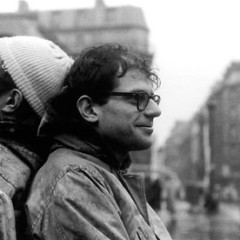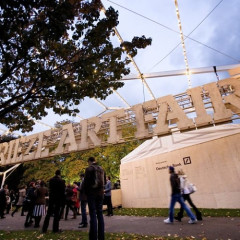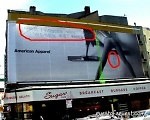 Breasts barely contained in her cotton shirt, she lustfully bites her lower lip as she stares out from the enlarged hazy black and white photograph with a "come hither" look. On another wall in the same space is an image of a topless woman, wearing a colorful pair of tights, bent over enticingly. Between the two is a photo montage covered in vintage copies of Playboy, Hustler and other girlie magazines. Though the images mounted upon the walls lack the airbrushed quality of the porn magazines, the overarching message of sex is still there.
Breasts barely contained in her cotton shirt, she lustfully bites her lower lip as she stares out from the enlarged hazy black and white photograph with a "come hither" look. On another wall in the same space is an image of a topless woman, wearing a colorful pair of tights, bent over enticingly. Between the two is a photo montage covered in vintage copies of Playboy, Hustler and other girlie magazines. Though the images mounted upon the walls lack the airbrushed quality of the porn magazines, the overarching message of sex is still there.
Walk through the doors of any one of the many American Apparel clothing stores popping up all across the country, and one is greeted by this visual onslaught of breasts, butts and other body parts.
Striking sexually explicit poses and scantily clad in the 100% cotton garb, which faintly hints at a notion of innocence and purity, these men and women appear anything but. Open a French fashion magazine and you may certainly find an advertisement for the same company with these seemingly barely-legal models adorned with nothing more than their birthday suits. Is American Apparel selling clothing via artistic photographs or is it merely a mask atop pornography?
"Do you really think it"s porn?" asks photographer Terry Richardson in an interview for the British publication, the Guardian. His work, like the American Apparel advertisements is portraits of people in compromising sexual positions. One particularly suggestive self-portrait displayed in a 2004 solo exhibition, entitled Terryworld at Deitch Projects (one of the many galleries in Chelsea) featured the artist exposed and all smiles as he receives fellatio from two naked models.
Terry Richardson is a celebrity in his own right. Born in the mid-1960s, his countless portraits of both American and international stars, along with advertisements for fashion designers like Gucci and Hugo Boss have been featured in Vogue, Harpers Bazaar and Sports Illustrated. In the same interview for the Guardian he claims,
"I"m just a regular guy who"s trying to deal with things, and figure stuff out as I go along. If people want to call it porn, that"s cool with me. If people are shocked or offended by it, that"s even better."
Mr. Richardson is merely one of the many contemporary artists whose photographs blur the line between art and pornography. The January 2007 issue of New York Magazine declared a triplet of artists were reinventing art and bringing back the bohemian cool to downtown New York. The work of the two photographers featured, Dash Snow and Ryan McGinley has, alongside Mr. Richardson, added strength to the movement. However, their images are raw and less focused on the glossy perfection of Mr. Richardson"s fashion crowd. They are less stylized, and perhaps more overtly sexual, intent on capturing real, predominately naked individuals engaged in sexual and drug related activities.
Nudes have been the focus of art since antiquity, but these new portraits are blatantly sexually charged. With just a quick glance into any magazine or a walk into any store, we see how this new style has penetrated fashion photography; however, we also see how it has been embraced by the art world. At 24, Ryan McGinley was the youngest person ever to have a solo exhibition at the Whitney Museum in New York and in 2007 he was declared Young Photographer of the Year by the International Center of Photography"s Infinity Awards. Perhaps as a result of cultural forces, particularly our increasing comfort with the hypersexualitization of many artistic and public outlets, we see how this new photography has provoked less controversy than artists a generation ago might have and has become a common theme in contemporary photography.
"I"ve been doing this for forty years, and I think it is a scam," declares Leonard Sussman adamantly. As a professor of photography and deputy chair of the fine arts department at Baruch College, Mr. Sussman is himself a fine arts photographer and finds the images distasteful and certainly "not cutting edge". Mr. Sussman believes this new photography is pornographic, he claims,
"I see nothing about those images that is remarkable as a photograph."
The ancient Greeks and Romans strove to capture the beauty of the human physique in their sculptures. For some time after, such displays of nudity were considered blasphemous and sinful until the Italian Renaissance again popularized the human form as they felt God intended it. The dawn of photography in the 19th century has merely provided an instantaneous means to capture the same splendor. Modern artists like Robert Mapplethorpe have placed a particularly strong emphasis on the power of the nude, effortlessly capturing the sinewy texture of every muscle in each black and white composition.
These new pornographic photographs follow a style made popular by Nan Goldin and Larry Clark. Both Goldin"s and Clark"s work is raw and gritty, and capture members of various American subcultures. It is true that these two artists do tackle rather controversial topics sexually in their work; however they lack the hedonistic wantonness of these new younger artists. The work of Nan Goldin and Larry Clark is difficult to handle at first glance but begs you to delve deeper in the image where you uncover a true story, one full of addiction and loneliness.
"This is not to say that art that deals with pain and squalor is necessarily better than art about beauty and fun. But by removing the shadows of complex human emotion from his post-adolescent pastorals, [Ryan] McGinley creates an aspirational brand of beauty that feels trivial and one-dimensional,"
writes art critic and senior research associate in the Department of Photographs at the Metropolitan Museum of Art, Mia Fineman in an essay for Slate magazine.
There has been much controversy over Nan Goldin"s photographs, particularly one entitled "Edda and Klara Belly Dancing." The photograph is one of the many pieces of artwork, which comprise the private collection of Sir Elton John. The image, which features two children dancing with one completely naked was exhibited last year in a gallery in the United Kingdom. Critics and officials were enraged believing the image to be child pornography. Similar charges of child pornography have been made against other renowned photographers including Jock Sturges and Sally Mann. Despite these charges, there is a beauty in their nudes, one not sexually explicit and serving a higher purpose.
At the heat of the debate is the difference between a naked subject and a nude. According to Kenneth Clark author of the 1956 book The Nude, "
"To be naked is to be deprived of our clothes and the word implies some of the embarrassment which most of us feel in that condition. The word nude, on the other hand, carries, in educated usage, no uncomfortable overtone. The vague image it projects into the mind is not of a huddled and defenseless body, but of a balanced, prosperous and confident body: the body re-formed."
These new photographs are depicting people naked and not in the traditional sense of the nude in art. However, the term nude does not refer to this ideal sort of beauty without clothing, but rather a tasteful depiction of the human form that serves a purpose in the artwork. The art porn of today is "still raw, and in that way [they] match the current raw pornography," says Suzanne Williamson, former photography editor for ARTnews magazine.
Pornographic elements within art may have arisen as a result of a general acceptance of and desensitization towards nakedness within our culture. Sex is everywhere. According to the Washington Post, "In the slightly more than 1,000 [television] shows scrutinized in [a 2005 study by the Kaiser Family Foundation], nearly 4,000 scenes had sexual content, compared with fewer than 2,000 in 1998, when the foundation started studying TV sex." Furthermore, Ms. Williamson contends, "From the now staid MTV, to "Girls Gone Wild", to celebrities caught without clothes or sanity, to "Last Night"s Party", the public desire today to see and know everything about people who seek or are thrust into public attention, is insatiable. Anyone can be stripped bare in a photo or viral video which circles the globe in seconds."
Both Dash Snow and Ryan McGinley are in their late twenties and very early thirties. Much of Mr. Snow"s photography and Mr. McGinley"s work revolves around seemingly endless bacchanalians and orgies reminiscent of college years. There is an exhibitionist quality to the subjects of these photographs, one clearly visible in the utilization of their nakedness.
Snow"s photo "Untitled, (Dakota smoking)," features three figures all nude strewn amongst the filth of what appears to be a cheap motel. One female obstructs the upper half of the man with her body, while the woman in the foreground smokes with one hand and keeps the lower half of the unknown man occupied with the other. Upon viewing this image, Mr. Sussman remarked, "
I see little difference between this and a porn website."
Much of Mr. McGinley"s earlier work was similar to the above mentioned; however at a current exhibition of his work at the Team Gallery (in Chelsea), his works have matured but still hold nakedness as a focal point.
"They understand that art is transgressive. It is about pushing buttons and boundaries. They need to go farther than their predecessors--although early Mapplethorpe work, now no longer shown, was more overtly sexual than either Snow or McGinley. It is about the shock," says Ms. Williamson.
The success of some of these artists further begs the question of whether or not art is judged on its own individual merit or on the parentage of the artists. When you are the son of a famous fashion photographer, as Terry Richardson or a descendent of the De Menil clan, the path to stardom in the art world is certainly less strenuous. "It is a real class issue because I see nothing outstanding about this as art," observes Mr. Sussman.
With the advances in digital photography, the relative low cost of a digital camera and the prevalence of cell phones, which have the dual capacity to snap photographs, it appears as though this sort of photography is on the rise. With a look at social-networking sites like myspace or Facebook, we see how the desire to provocatively capture individuals on film will continue to play a role in society and thus the art world. Ms. Williamson sagely notes,
"Art is driven by its obsessions and passions."

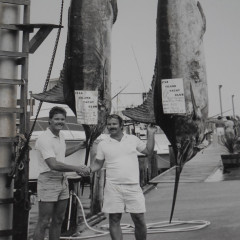
.jpg)
.jpg)
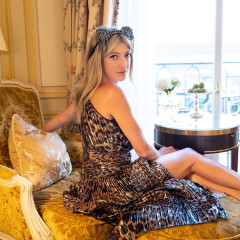


.jpg)
.jpg)
.jpg)

